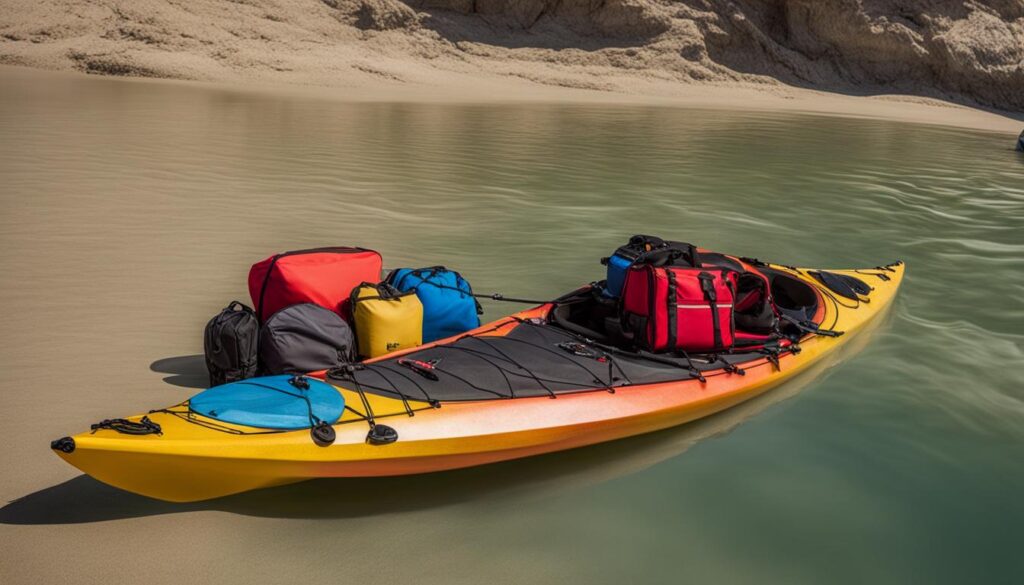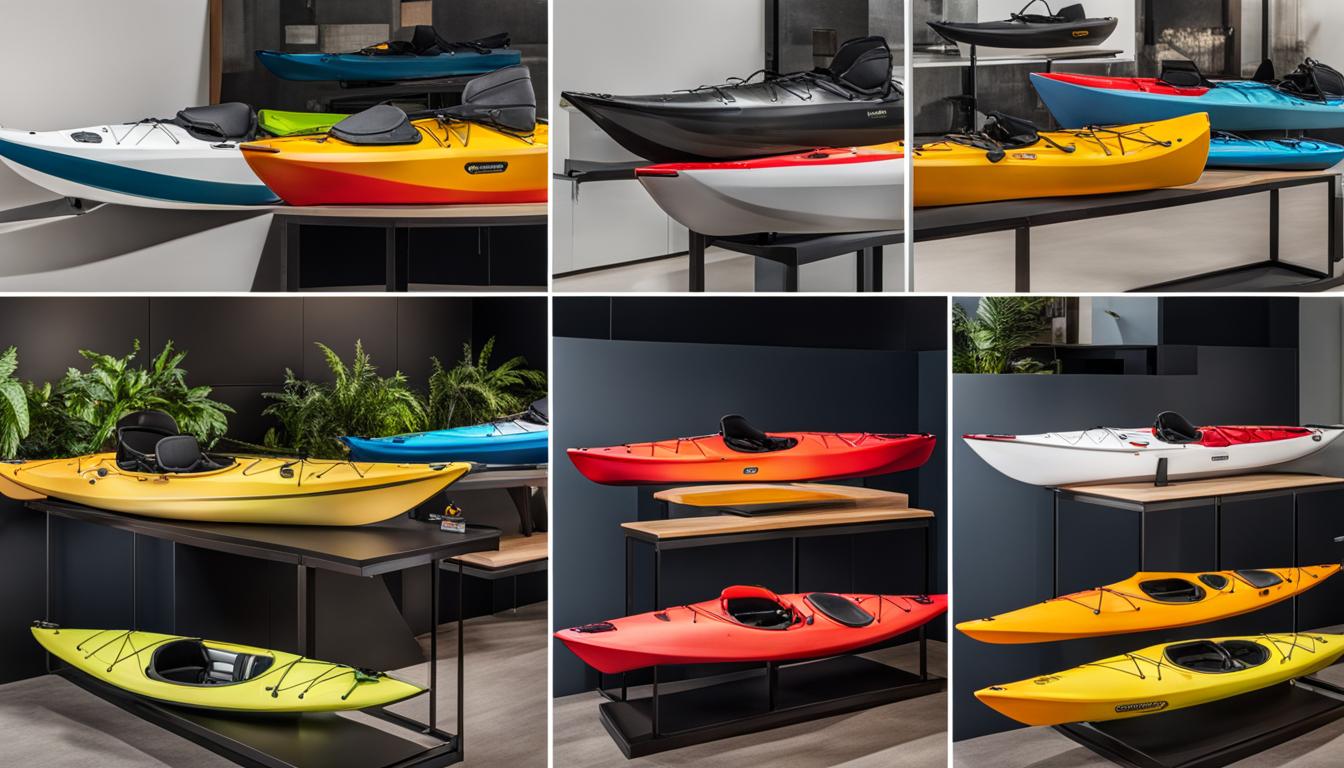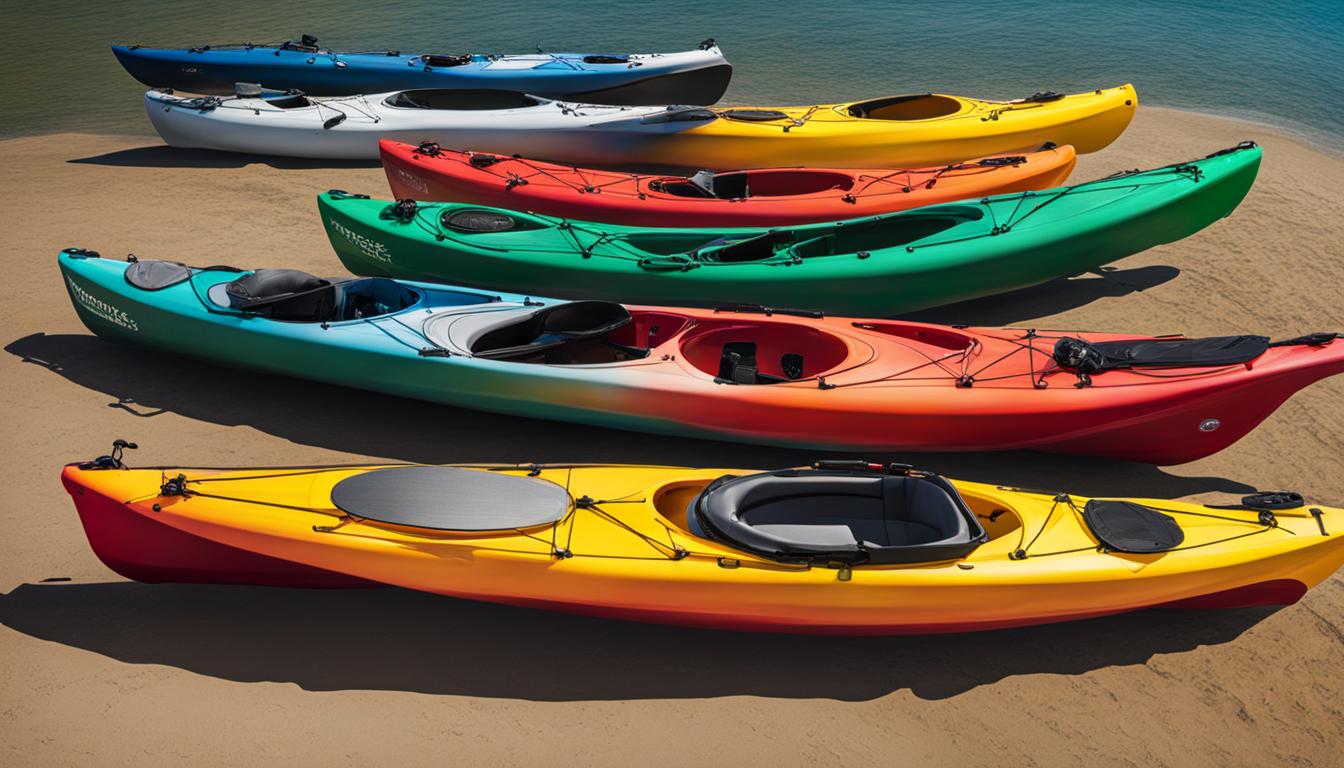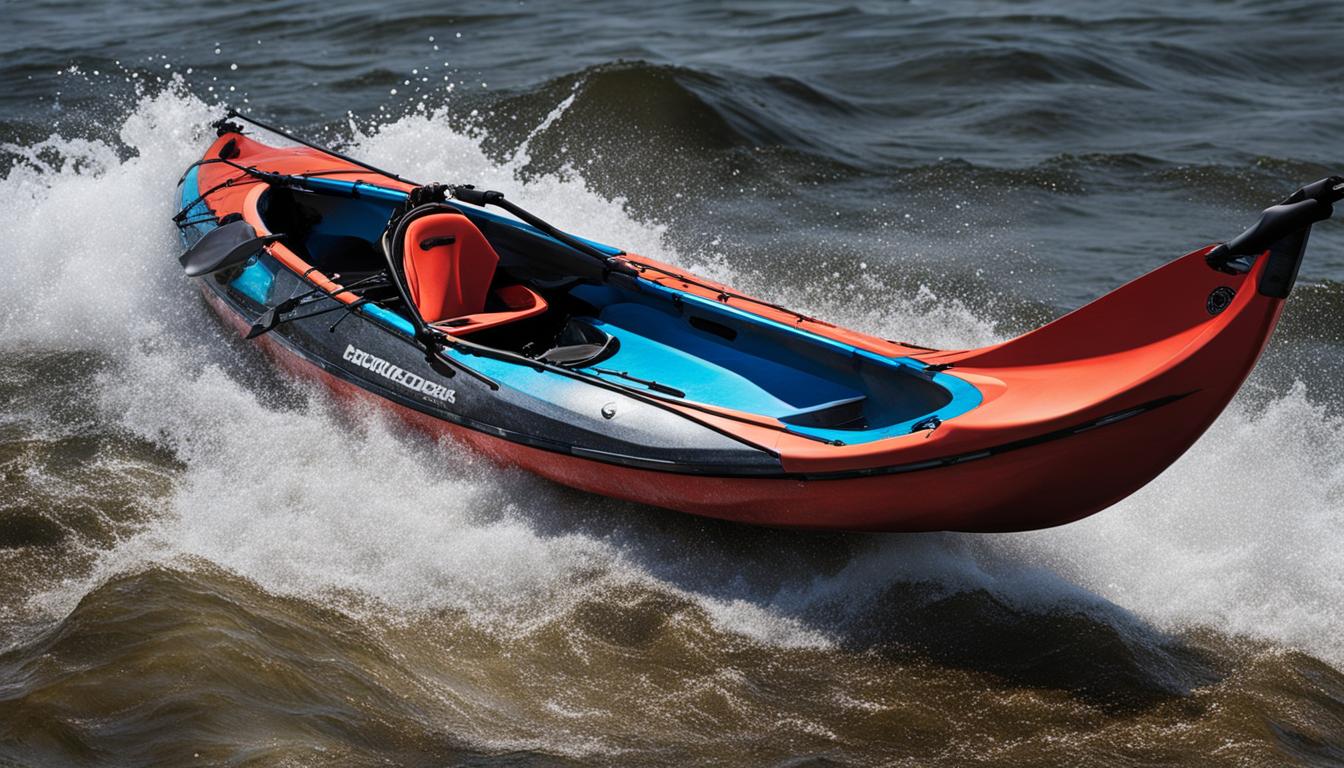Are you ready to embark on a thrilling kayaking adventure? Before you hit the water, it’s important to follow a step-by-step kayak buying process to choose the right kayak that suits your needs. Whether you’re a seasoned kayaker or a newbie, these kayak purchase decision factors will help you make an informed choice.
Key Takeaways:
- Consider your skill level and the environment you’ll be kayaking in.
- Determine the type of kayak that suits your needs and preferences.
- Explore the various options available in the market, such as sit-on-top kayaks, sit-in kayaks, recreational kayaks, touring kayaks, whitewater kayaks, inflatable kayaks, and wooden kayaks.
- If buying a used kayak, inspect its condition, how it was stored, and test paddle it.
- Research pricing and where to buy used kayaks, such as online marketplaces, kayak shops, and classified ads.
Identifying Your Kayaking Environment
Before choosing a kayak, it’s important to identify the type of environment you’ll primarily be kayaking in. There are two main types of water environments – inland waters and open waters. Each environment has different characteristics and requires a different type of kayak for optimal performance.
Inland Waters
Inland waters refer to lakes, rivers, and canals. These environments are typically calmer and more protected compared to open waters. When kayaking in inland waters, you can expect smoother and more predictable conditions, which are ideal for recreational kayaking or exploring scenic waterways.
- Recreational Kayaks: These kayaks are designed for stability and ease of use, making them perfect for beginners or casual paddlers. They provide comfort and maneuverability for relaxed kayaking experiences on calm inland waters.
- Touring Kayaks: Touring kayaks are ideal for longer trips and expeditions on inland waters. They offer additional storage space for gear and supplies, as well as enhanced tracking and efficiency for covering greater distances.
Open Waters
Open waters encompass larger bodies of water such as oceans and large lakes. These environments are more exposed to wind, waves, and currents, requiring kayaks with specific features to ensure safety and performance.
- Sea Kayaks: Sea kayaks are designed for navigating open waters and handling rougher conditions. They have longer, narrower hulls for increased speed and stability, along with watertight hatches for storage and a skeg or rudder for improved tracking and maneuverability.
- Surf Kayaks: If you’re interested in riding waves and catching surf, a surf kayak is the right choice for you. These kayaks have a specialized design for riding waves and performing maneuvers in the surf zone.
By identifying where you will be using your kayak, whether it’s inland waters or open waters, you can narrow down your options and choose a kayak that’s best suited for your intended environment. Remember to consider factors such as the water conditions, your experience level, and the type of kayaking you plan to do to ensure a safe and enjoyable kayaking experience.
Types of Kayaks and Their Uses
When it comes to choosing a kayak, there are several types available, each designed for different activities and preferences. Understanding the different types of kayaks and their specific uses can help you make an informed decision and find the perfect kayak for your needs.
Sit-on-Top Kayaks
Sit-on-top kayaks are popular for their ease of use and versatility. These kayaks have an open cockpit design which allows you to sit on top of the kayak rather than inside. They are great for recreational paddling, fishing, and diving, as they provide easy entry and exit and have self-bailing features to drain water that may enter the cockpit.
Sit-In Kayaks
Sit-in kayaks, on the other hand, have a closed cockpit design where you sit inside the kayak. These kayaks offer better control and protection from the elements, making them suitable for touring, longer trips, and paddling in colder weather. They also tend to be more efficient in terms of speed and tracking.
Recreational Kayaks
Recreational kayaks are designed for casual paddlers who want to enjoy calm waters, such as lakes and slow-moving rivers. These kayaks are stable, easy to maneuver, and often come with comfortable seating and storage options for day trips.
Touring Kayaks
Touring kayaks are built for more adventurous paddlers who want to explore larger bodies of water and go on multi-day trips. These kayaks are longer, narrower, and have a higher storage capacity, allowing you to carry gear and essentials for longer journeys. They offer better tracking and efficiency for covering longer distances.
Whitewater Kayaks
If you’re an adrenaline junkie and enjoy fast-moving waters and challenging rapids, whitewater kayaks are designed for you. These kayaks are shorter and more maneuverable, allowing you to navigate through turbulent waters with ease. They are built to withstand the impact of rocks and provide stability in dynamic environments.
Inflatable Kayaks
Inflatable kayaks offer the convenience of easy transportation and storage. These kayaks can be deflated and packed into a small bag, making them ideal for travelers or those with limited storage space. Despite their inflatable nature, they are durable and stable, suitable for recreational paddling in calm waters.
Wooden Kayaks
Wooden kayaks are a unique choice for those who appreciate craftsmanship and aesthetics. These kayaks are handcrafted from wood, providing a classic and elegant look. They offer a smooth and quiet paddling experience and are highly sought after by kayak enthusiasts.
| Kayak Type | Uses |
|---|---|
| Sit-on-Top Kayaks | Recreational paddling, fishing, diving |
| Sit-In Kayaks | Touring, longer trips, paddling in colder weather |
| Recreational Kayaks | Calm waters, day trips |
| Touring Kayaks | Exploring larger bodies of water, multi-day trips |
| Whitewater Kayaks | Fast-moving waters, challenging rapids |
| Inflatable Kayaks | Easy transportation, recreational paddling |
| Wooden Kayaks | Classic look, smooth paddling experience |
Things to Consider When Buying a Used Kayak
Buying a used kayak can be a great option for those looking to save money without compromising on quality. However, there are a few important factors to consider to ensure you make a wise purchase decision. When inspecting a used kayak, take note of its condition to ensure there are no significant damages or deformities that may affect its performance. Look for signs of wear and tear, such as cracks, dents, or repairs, and pay close attention to the overall stability and structural integrity of the kayak.
Another crucial aspect to evaluate is how the kayak was stored. Improper storage can lead to issues like warping or degradation of the kayak’s materials. Check if the kayak was stored indoors or outdoors, and if it was exposed to extreme temperatures or direct sunlight for extended periods. Ideally, a kayak should have been stored in a dry, protected area away from harsh environmental conditions.
Test paddling the kayak is highly recommended to get a feel for its performance on the water. This will allow you to assess how the kayak handles, tracks, and maneuvers, giving you a better idea of whether it suits your paddling style and preferences. It’s also an opportunity to check for any leaks or water seepage, as this could indicate potential problems with the kayak’s hull or seams.
Furthermore, don’t forget to consider the accessories and additional equipment that may come with the used kayak. Check if it includes any paddles, life jackets, or other accessories, as this can add value to your purchase. Additionally, consider the age of the kayak and its manufacturer’s warranty, if applicable, to gauge its remaining lifespan and potential for future repairs or maintenance.
| Things to Consider When Buying a Used Kayak: |
|---|
| Inspect the kayak’s condition for damages or deformities |
| Determine how it was stored to ensure its quality |
| Test paddle the kayak to evaluate its performance on the water |
| Consider any included accessories and additional equipment |
| Take into account the age of the kayak and its warranty |
By taking these factors into consideration, you can make an informed decision when buying a used kayak. Remember to prioritize quality and safety, ensuring that the kayak meets your specific needs and preferences. With careful evaluation and proper inspection, you can find a reliable used kayak that allows you to enjoy countless adventures on the water.
Pricing and Places to Buy Used Kayaks
When considering purchasing a used kayak, it’s important to take into account the cost and where to buy one. The price of used kayaks can vary depending on factors such as the brand, condition, and age of the kayak. By doing some research and comparing prices, you can ensure that you’re getting a fair deal. It’s recommended to check multiple sources, including online marketplaces, kayak shops, and classified ads, to find the best options.
Online marketplaces such as Craigslist, eBay, and Facebook Marketplace are popular places to buy used kayaks. These platforms often have a wide selection of kayaks from individuals looking to sell their used gear. However, it’s important to exercise caution and thoroughly inspect the kayak before making a purchase. Ask for detailed information and photos, and if possible, arrange to see the kayak in person to ensure its condition meets your expectations.
Kayak shops are another great place to buy used kayaks. These shops often offer a curated selection of pre-owned kayaks that have been inspected and are in good condition. The advantage of buying from a kayak shop is that you can rely on their expertise and knowledge to guide you in finding the right kayak for your needs. Plus, you may have the opportunity to try out the kayak before making a purchase, ensuring it suits your paddling style and preferences.
Lastly, don’t overlook classified ads in local newspapers or online forums dedicated to kayaking. These platforms can connect you with individuals who may be selling their kayaks at a reasonable price. However, be sure to ask the right questions and thoroughly inspect the kayak before finalizing the transaction.
| Platform | Pros | Cons |
|---|---|---|
| Online Marketplaces | – Wide selection | – Limited ability to inspect before purchase |
| Kayak Shops | – Inspected, good condition kayaks | – Potentially higher prices |
| Classified Ads | – Potential for good deals | – Limited selection |
Buying a used kayak can be a cost-effective solution for those looking to get into kayaking or upgrade their current gear. By considering the cost and exploring different purchasing options, you can find a quality used kayak that suits your needs and budget. Remember to always thoroughly inspect the kayak and ask the right questions to ensure you’re making a smart purchase.
Tips for Buying a Used Kayak
- Research and compare prices from different sources
- Thoroughly inspect the kayak for any damage or deformities
- Check how the kayak was stored to ensure it’s in good condition
- If possible, take the kayak for a test paddle to assess its performance
- Consider buying from reputable kayak shops for added peace of mind
By following these tips and being diligent in your search, you can find a quality used kayak at an affordable price, allowing you to enjoy the thrill of kayaking without breaking the bank.

The Importance of Choosing the Right Kayak
When it comes to kayaking, choosing the right kayak can greatly impact your overall experience on the water. Whether you’re a beginner or an experienced kayaker, finding the perfect kayak that suits your needs is essential for maximizing your enjoyment and safety.
One of the key factors to consider when selecting a kayak is your skill level. Different kayaks are designed for different skill levels, ranging from beginner-friendly recreational kayaks to more advanced touring or whitewater kayaks. By choosing a kayak that matches your skill level, you can ensure that you feel comfortable and confident while paddling.
Another important aspect to consider is the intended use of the kayak. Are you planning to explore calm inland waters or venture into more challenging open waters? Do you envision taking leisurely day trips or embarking on multi-day adventures? Understanding the type of environment you’ll be kayaking in and the activities you’ll be participating in can help you narrow down your options and select a kayak that is well-suited for your specific needs.
Additionally, it’s crucial to take into account personal preferences such as comfort, stability, and storage capacity. Some kayakers prioritize maneuverability and speed, while others value stability and ease of entry. By considering these factors, you can make a smart investment in a kayak that aligns with your preferences and enhances your overall kayaking experience.
“Choosing the right kayak is like finding the perfect fit for your outdoor adventures. It’s important to take the time to research, try different models, and consider your own preferences. By doing so, you can make a smart kayak investment that will provide you with years of enjoyment on the water.”
Tips for Beginners and Novice Kayakers
If you’re a beginner or novice kayaker, there are several tips you can follow to ensure a smooth and enjoyable kayaking experience. By taking the time to prepare and educate yourself, you can make an informed decision when purchasing a kayak and avoid common pitfalls.
1. Do Thorough Research
Before buying a kayak, it’s important to do your homework. Research different types of kayaks, their features, and their suitability for your intended use. Take the time to read reviews, watch videos, and gather as much information as possible to make an informed decision.
2. Seek Advice
Reach out to experienced kayakers or join online communities and forums for valuable advice and insights. They can provide tips on kayak selection, safety guidelines, and even recommend local kayaking spots. Learning from those who have been kayaking for a while can help you avoid common beginner mistakes.
3. Consider Lessons or Join a Kayaking Club
If you’re completely new to kayaking, consider taking lessons or joining a kayaking club. Certified instructors can teach you proper paddling techniques, safety protocols, and help you build confidence on the water. Joining a club also provides an opportunity to meet like-minded individuals and learn from their experiences.

4. Test the Waters
Before making a final purchase, try renting or borrowing a kayak to test it out. This allows you to get a feel for different types of kayaks and determine which one suits you best. Testing the waters also helps you understand your preferences in terms of stability, maneuverability, and comfort.
By following these tips, you can prepare yourself for a kayak purchase and ensure you make a quality buy. Remember, kayaking is not just about the equipment but also about the knowledge and skills you acquire along the way. So, dive in, explore the waters, and enjoy the adventure that kayaking has to offer!
Conclusion
Purchasing a kayak is an exciting step towards exploring the water and enjoying outdoor adventures. By following the steps outlined in this kayak selection guide, considering your skill level and kayaking environment, and choosing the right type of kayak, you can make a smart investment and find the perfect kayak for your needs.
Whether you decide to buy a new or used kayak, ensuring its quality and taking the necessary precautions will contribute to a successful and enjoyable kayaking experience. Remember to buy a kayak online from reputable sellers who provide detailed information about the kayak’s condition and offer secure payment options.
Now that you have the knowledge and understanding of the kayak buying process, you’re equipped to make an informed decision. Take your time, do your research, and consider reaching out to experienced kayakers for additional guidance. With the right kayak in your possession, you’ll be ready to embark on unforgettable paddling adventures and create lasting memories on the water.
FAQ
What factors should I consider when purchasing a kayak?
When purchasing a kayak, it’s important to consider your skill level, the type of environment you’ll be kayaking in, and your personal preferences.
What type of kayak should I choose for different water environments?
For inland waters, such as lakes and rivers, you can consider sit-on-top kayaks or sit-in kayaks. For open waters, such as oceans and large lakes, sit-in kayaks are generally more suitable.
What are the different types of kayaks available?
There are various types of kayaks available, including sit-on-top kayaks, sit-in kayaks, recreational kayaks, touring kayaks, whitewater kayaks, inflatable kayaks, and wooden kayaks.
What should I check when buying a used kayak?
When buying a used kayak, it’s important to inspect it for any damage or deformities, check how it was stored, and even take it for a test paddle to assess its performance.
Where can I buy used kayaks?
You can buy used kayaks from online marketplaces, kayak shops, and classified ads. It’s recommended to compare prices and do some research before making a purchase.
Why is choosing the right kayak important?
Choosing the right kayak is important because it can enhance your performance, provide comfort, and ensure your safety on the water.
What tips do you have for beginner kayakers?
For beginners, it’s important to do thorough research, seek advice from experienced kayakers, and consider taking lessons or joining a kayaking club to prepare for a kayak purchase.





